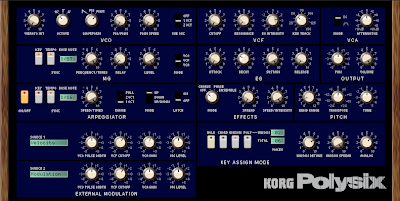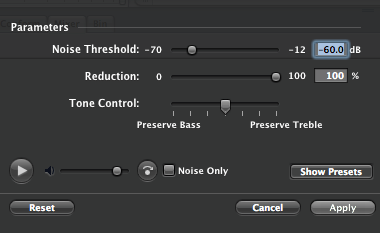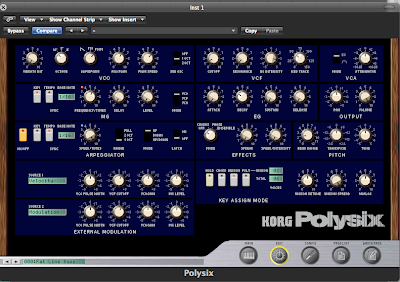
(Click image to enlarge and see settings)
Although it has its origins in the early 2000's, it wasn't until the last 2-3 years that dubstep emerged out of the deepest recesses of the underground. Although still semi-obscure, the popularity of dubstep has increased enough that there are several dubstep-oriented sample libraries on the market now. But of course, it's much more fun to make your own sounds, so today I'm going to show you how to program a dubstep bass using Korg's excellent PolySix emulation.
1. Load up an instance of Polysix in your sequencer of choice. It defaults to the Fat Line Bass setting, which is as good as any place to start. For whatever reason, square (pulse) waves seem to be the most common waveform used in making dubstep basses, so go ahead and chance the WAVEFORM to PW or PWM. It doesn't matter which, as we won't be modulating the pulse width, we'll just be leaving it as a square. While you're in the VCO section, go ahead and drop the OCTAVE setting to 16', as this is the lowest.
2. The original sound is sort of short and plucked, but we want a sustaining sound, so head over to the EG section and throw the SUSTAIN level all the way up to 10. Your ATTACK and RELEASE should be set at 0, and because of the SUSTAIN setting, the DECAY setting isn't important.
3. Next, go up to the VCF section, and turn the filter's CUTOFF all the way down to 0. It's pretty dark and muffled now, but don't worry, we'll be modulating it to change that.
4. So head over to the MG section (Modulation Generator... Korg's name for an LFO). Change the MOD switch to VCF so we're telling the MG to modulate the filter. Make sure the KEY and TEMPO buttons are both selected. Dubstep is a style that relies heavily on syncopation and triplet feels, so we're going to set the BASE NOTE to 1/8T (triplet eigth notes). Note that changing the LFO rate throughout the course of a bassline is quite popular in dubstep, and you can do that by changing the BASE NOTE setting using your sequencer's automation.
5. Finally, we want this sound to be big and fat, so make sure your KEY ASSIGN MODE is set to UNISON. Crank the UNISON DETUNE up to around 6 or 7 and the UNISON SPREAD all the way to 10.
If you've done everything correctly, you should have something that sounds like this (note that I am automating the BASE NOTE setting here as mentioned above):






















































